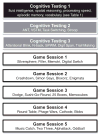Selling points: What cognitive abilities are tapped by casual video games?
- PMID: 23246789
- PMCID: PMC3679476
- DOI: 10.1016/j.actpsy.2012.11.009
Selling points: What cognitive abilities are tapped by casual video games?
Abstract
The idea that video games or computer-based applications can improve cognitive function has led to a proliferation of programs claiming to "train the brain." However, there is often little scientific basis in the development of commercial training programs, and many research-based programs yield inconsistent or weak results. In this study, we sought to better understand the nature of cognitive abilities tapped by casual video games and thus reflect on their potential as a training tool. A moderately large sample of participants (n=209) played 20 web-based casual games and performed a battery of cognitive tasks. We used cognitive task analysis and multivariate statistical techniques to characterize the relationships between performance metrics. We validated the cognitive abilities measured in the task battery, examined a task analysis-based categorization of the casual games, and then characterized the relationship between game and task performance. We found that games categorized to tap working memory and reasoning were robustly related to performance on working memory and fluid intelligence tasks, with fluid intelligence best predicting scores on working memory and reasoning games. We discuss these results in the context of overlap in cognitive processes engaged by the cognitive tasks and casual games, and within the context of assessing near and far transfer. While this is not a training study, these findings provide a methodology to assess the validity of using certain games as training and assessment devices for specific cognitive abilities, and shed light on the mixed transfer results in the computer-based training literature. Moreover, the results can inform design of a more theoretically-driven and methodologically-sound cognitive training program.
Copyright © 2012 Elsevier B.V. All rights reserved.
Figures




References
-
- Ackerman PL, Kanfer R, Calderwood C. Use it or lose it? Wii brain exercise practice and reading for domain knowledge. Psychology and Aging. 2010;25(4):753–766. http://dx.doi.org/10.1037/a0019277. - DOI - PMC - PubMed
-
- Ackerman PL. Determinants of individual differences during skill acquisition: Cognitive abilities and information processing. Journal of Experimental Psychology. General. 1988;117(3):288–318. http://dx.doi.org/10.1037/0096-3445.117.3.288. - DOI
-
- Basak C, Boot WR, Voss MW, Kramer AF. Can training in a real-time strategy video game attenuate cognitive decline in older adults? Psychology and Aging. 2008;23(4):765–777. http://dx.doi.org/10.1037/a0013494. - DOI - PMC - PubMed
-
- Bennett GK, Seashore HG, Wesman AG. Differential aptitude test. San Antonio, TX: The Psychological Corporation; 1997.
Publication types
MeSH terms
Grants and funding
LinkOut - more resources
Full Text Sources
Other Literature Sources
Medical
Miscellaneous

